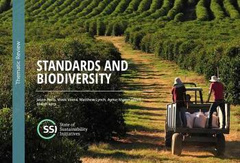"Standards and Biodiversity" Thematic Review analyzes relationship between biodiversity and sustainability standards
How do sustainability standards integrate biological diversity? This question attracts an increasing attention. Now researchers had a look into 15 voluntary standards in the agriculture sector. The State of Sustainability Initiatives (SSI) and the International Institute for Sustainable Development (IISD) published the results in their "Standards and Biodiversity" Thematic Review.
The review covers standard initiatives operating in the banana, cocoa, coffee, cotton, palm oil, soy, sugar, tea and cereals (rice, maize and wheat) sectors. The impetus for the study came from the CBD work on "Biodiversity Impact Indicators for Commodity Production (BIICP)". The review attempts to understand the degree to which major vuluntary sustainability standards operating in the agriculture sector are aligned with the specific biodiversity-related objectives targeted by the BIICP.
The study is a criteria-based analysis dealing with the criteria and aspirations of the different standard initiatives. It is not about actual imapcts and outcomes.
A small selection of the key findings and messages (quotes from the text):
- Although the standards reviewed revealed relatively broad coverage of key biodiversity-related pathways, criteria explicitly focusing on biodiversity protection are relatively rare among the initiatives surveyed, with only 40 per cent of initiatives specifying critical requirements for risk assessment of biodiversity impacts and 13 per cent requiring that agricultural practices produce no net loss of biodiversity.
- Overall, the standards reviewed focus on the protection of environmental systems rather than the measurement and monitoring or restoration of such systems. Similarly, the vast majority of requirements focus on farm-level practices rather than actual outcomes. […] leaving a vacuum of data and evidence with respect to actual impacts.
- Notwithstanding the significant market growth of voluntary standards across select agricultural sectors, standards remain a marginal force across global agricultural production as a whole. […] If voluntary standards are to play a major role in reducing the impacts of agriculture on biodiversity loss, they will have to, at a minimum, establish a significant presence among other crops—most notably, staple crops such as wheat, maize and rice.
- The requirements specified by voluntary standards prioritize protection against habitat loss, historically the single most important driver of agriculturally caused biodiversity loss. Voluntary sustainability standards are less well prepared to deal with impending drivers of biodiversity loss such as climate change.
- The current and ongoing focus of voluntary standards on practice-based requirements through farm-specific interventions potentially limits their ability in bringing about broader landscape or regional changes.
- The potential for voluntary standards to adapt to the needs of specific stakeholders may be both their greatest strength and their greatest weakness.
<link http: www.iisd.org sites default files publications standards-biodiversity-ssi-report.pdf _blank external-link-new-window externen link in neuem>Download of the full report. The report contains an executive summary on pages 6-11.

